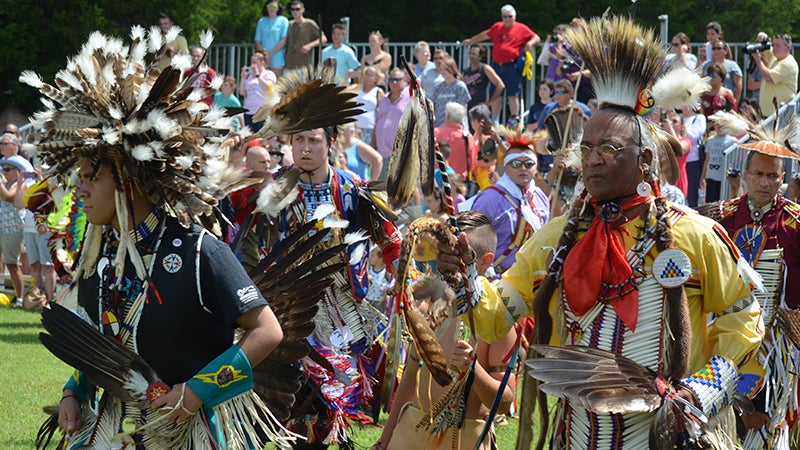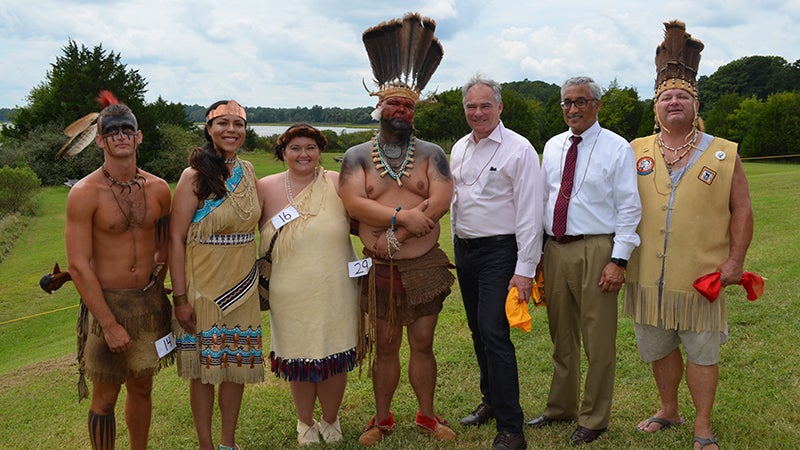Powwow marks celebration of heritage and progress
Published 8:57 pm Saturday, August 18, 2018
Thunderous drum beats, rhythmic chanting and authentic regalia set the scene on a hot and humid Saturday afternoon by the Nansemond River, where hundreds of people gathered to enjoy food and good company in celebration of both heritage and the federal recognition that was finally granted to the Nansemond Indian Nation earlier this year.
The revelry was on full display inside a ceremonial circle roughly 600 feet in diameter surrounded by bleachers, tents and lawn chairs. The dancers brought the Nansemond’s 30th annual powwow to life with each motion and moccasin-clad step on the grass.
“It’s probably one of the most powerful things we can do as a people,” said Keith Anderson of the Nansemond tribe, wearing a feathered headdress and pieces of brown and brightly-colored regalia, a set of clothing he’s accumulated over decades.
The powwow is being held Saturday and Sunday on the tribe’s Chuckatuck land at 1001 Pembroke Lane, where more than 170 cars, trucks and motorcycles arrived on Saturday. It’s the site of the tribe’s Mattanock Town village with authentic dwellings and wooded trails.
Master of Ceremonies Kay Oxendine said Saturday was an impressive turnout for the celebration.
“I’ve been doing this here for about eight years, and I’ve never seen this many people. I know it’s going to be a good day,” Oxendine said. Visitors included at least 100 registered dancers just before the grand entry ceremony at noon.
Visitors browsed approximately 30 different vendors like Dream Catcher Alley and the Chickahominy Beaded Turtle. Children played games and stopped by the petting zoo. Whole families lined up at the lodge for their choice of lunch, whether it was hot dogs, burgers or the crowd-pleasing “Indian Tacos,” a delicious marriage of fried bread and taco toppings as big as the paper plates they’re served on.
The powwow is organized in cooperation with the city of Suffolk, and its main event is its ceremonial circle, where those well-fed families enjoyed hours of exciting dances to the beat and singing of drum groups Thunder Voice, Stoney Creek and War Paint.
“It’s beautiful,” said Ambrea Clairborne, who sat in the bleachers with her husband, Jason Johnson, and their children Kevin, 9, and Owen, 4. “I love the regalia. They’re very beautiful and brightly colored. It really shows their pride in their heritage.”
Oxendine said that each piece of regalia is typically made special for a dancer or is made by the dancer.
Brandon Adkins, a resident of Charles City and member of the Chickahominy tribe, spent about a year crafting his “fancy dance” wear, a design of vibrant colors that features a broad bustle of feathers. The colors and feathers combine for a dizzying display when he’s spinning to the drum beats.
“It’s what I love to do, and it means more to me to make it myself rather than to go out and buy it,” he said.
After the eagle staff was brought in during the grand entry ceremony, the afternoon alternated between different styles and formation of dance, including one where veterans were invited into the circle. They were honored with singing, handshakes and cheers.
“At powwows, we make sure that our veterans are treated very special,” Oxendine said. “We make sure we do a veteran’s dance and that the audience acknowledges their service. It’s really important to us.”
Numerous tribes are represented at the Nansemond powwow each year. Oxendine explained that while they may have different blood, each participant is part of the “powwow family.”
It’s a fitting description considering that the celebration is described as a “homecoming,” a feeling that seasoned dancers shared among one another.
“It feels a lot like coming home, especially when you dance for a couple of years,” according to Russell Reed, 25, a Matthews County resident and member of the Atakapa tribe. Reed has been dancing at powwows for about nine years, but Saturday was his first one in Suffolk.
It was also the first visit for Kaylana Gates, 24, a Richmond resident with ties to both the Nottoway and Nansemond tribes and five years of first-hand dancing experience.
“It makes you feel good because you get to see that our people our still so strong,” she said. “You get to feel that.”
The powwow is meant to honor the heritage of these tribes and also remember those that came before. Earl Bass, chief emeritus of the Nansemond Indian Tribe, did that with a list of names he recited into the microphone.
“I wanted to read off those names of those that came before us. People that have passed on to the great creator in the last 30 years,” Bass said. “They have been the people that have gotten us to where we are today.”
This year’s celebration was also about progress, starting with the “Thomasina E. Jordan Indian Tribes of Virginia Federal Recognition Act of 2017” in January. Signed by President Donald Trump on Jan. 28, the bill granted federal recognition to six Indian tribes in Virginia, including the Nansemonds.
This allows the tribe to have legal standing with the U.S. government and access to educational scholarships, health care services and other benefits. Recognition took generations of patience and perseverance from members of the tribe and their supporters in government.
Virginia Sen. Tim Kaine and Congressman Bobby Scott, the tribe’s supporters that helped push this bill all the way through the Senate, attended Saturday’s celebration.
Kaine described that day in January when the bill passed the Senate, with each tribe’s chief watching from the gallery.
“The chiefs came down and I said to them, ‘I thought you might give up on us, but I knew that you would never give up,” Kaine said.
This year, the Nansemonds also became the first tribe to join the Sons of the American Revolution, Nansemond Chief Lee Lockamy said, but there’s more work yet to be done.
The tribe plans to keep expanding Mattanock Town to include a new building for the purpose of establishing a museum for their history, he said.
“We’re going to be able to present our history like it really was, because we have the funding to do it now,” he said.
One of the dances on Saturday afternoon was called the “round dance.” Tribal dancers formed a circle alongside excited members of the audience around the perimeter, and numerous children formed a smaller circle inside, stepping hand-in-hand.
Lockamy said the powwow allows the tribes to share their culture with the public.
“I think it allows the people to come in and experience what we feel,” he said.








